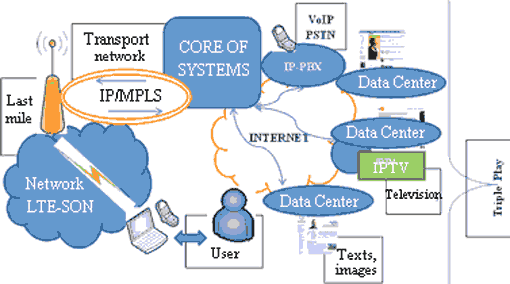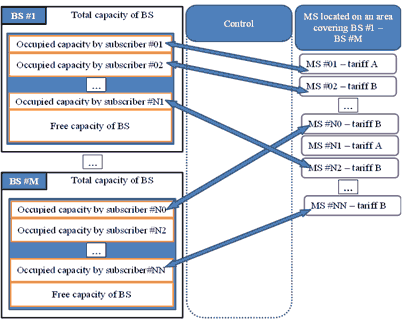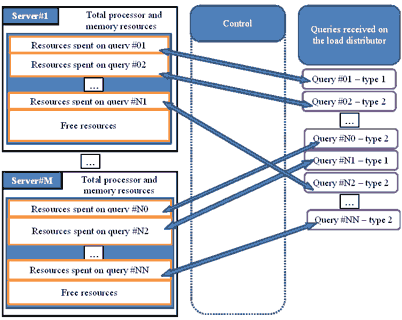INTRODUCTIONOne of the main problems of telecommunications is uneven network load at different time periods and in different parts of network. As a result, economic efficiency is reduced. The problem is solved by introduction of additional resources: redistribution available resources dynamically. There are dynamic systems of load redistribution in any segment of telecommunication network: load-balancing in a data center; control flows protocols [1,2] in the transport segment IP/MPLS; SON (Self-Organization Network) concept in the 4th generation mobile networks [3]. But all these systems use different methods, algorithms and principles of organization to solve the problem of load balancing. We can accelerate the process of solving the problem, if we split it into 2 parts: the development of a universal model and its adaptation to the different systems. The purpose of this work is to enhance the effectiveness of research process of load-balancing systems in telecommunication networks through the development of specialized software application and development of own load-balancing algorithm based on the results of investigations. To achieve these goals next tasks were set: – analysis of trends in the development of telecommunications networks and load balancing methods; – development of universal software model for the system with the load balancer; – model adaptation to investigate load balancing in the data center and in self-organizing networks; – development own studies of the algorithm for the load balancing on the basis of analysis. The universal model of a system that implements the functions of flow distribution was first proposed in this work. The software to study load balancing in 4 generation cellular networks and data centers will be developed. |

Scientific supervisor: Ph.D. (in Technical), Associate Professor of the department AT Victoria Voropaeva
en
ua


ANALYSIS OF THE RESEARCH OBJECTAnalysis of contemporary trends in the telecommunications sectorIt was analyzed statistics of providing telecommunications services in Ukraine [4] and the leader of the introduction of modern telecommunications technology - Sweden [5]. Market for fixed line is decrease [6], and for mobile (cellular) is increase. Similarly grows the rate of provision services broadband access to the Internet. This trend is confirmed by MTS [7] and iKS CONSTULTING [8]. Confirmation of these trends noted in the statistics: – Reducing the use of fixed voice services and terrestrial television [9]. – Increasing demand for VoIP [11,12]. – Growth of Internet video traffic [10]. The most popular service will be a broadband Internet. Within this access will be implemented services of voice communications, TV and data transmission. The latest technologies, which are focused on the provision of broadband services: – mobile networks 4th generation (LTE [3,13-17], WiMAX [18,19]); – technology of providing multi-service IP / MPLS [2,20,21]; – marketing concept Triple Play [22]; – services of distributing computing data centers [23-25]. |
|
Picture 1 - Network Triple Play, which is based on latest technologies |
Analysis of load-balancing systems in data centersMajor media sites are visited by millions people every day [26]. An enormous clusters computing systems are required to provide such service. There is data of Twitter [27] to estimate the load: – about 600 requests per second; – the system supports 200-300 (average) connections per second; – MySQL handles about 2,400 queries per second; – the average response to a query to a database of 50-100 milliseconds. The load balancer is used to organize these cluster computing centers, take a decision of the direction of each request. Each server in their capabilities (speed of response, speed of service a particular request type, multi-threading, etc.) is a special unit. Each request has its own type, purpose, size and work time of service - "weight" for the resources of cluster for its processing (picture 2). Resources of processor and memory of each server are redistributed between the incoming requests according to different algorithms of load balancing during the work of cluster. (Round Robbin, Least Connected, Weighted Round Robbin, Multi Class Round Robbin, Locality aware Request Distribution, etc.) |
|
Picture 2 - The structural pattern of flows in the data center |
The load balancing in the network LTE-SON by using the properties of self-organizationMobile technology LTE and WiMAX provide speeds comparable to fixed access channels [17]. Self Organization Network (SON) is easily integrated into LTE due to the existing interfaces, modules and network control protocol [13-16]. The exchange of information between base stations (BS) allows the neighboring base stations agree on power radiation of its transceiver devices and determine the uneven load on the network. Changing power of BS leads to a redistribution of mobile station (MS) between the BS according to the criterion of uniformity of loading. The main resource in the LTE-SON is the total bandwidth of each BS broadcast. This resource is distributed on the basis of existing tariff plans, the requirements for quality of service, location MS and others (picture 3). |
|
Picture 3 - The structural pattern of flows in the LTE-SON |
DEVELOPMENT OF THE UNIVERSAL MODELThe main feature of the developed model is its versatility. Systems of the distribution and use of these systems are quite different, but structurally the process of a balancing is the same for these systems. This allows us to formulate a universal software model. Software model (framework) should not only describe the process, but give a flexible mechanism for modeling, research and management of the model itself. Typical element in all structures is the flow: requests, packets, instant bandwidth. Therefore, the object is selected - "Flow" - a multidimensional array. The first value is the unique key (the countdown for the query, UID for mobile stations). Other values are a set of parameters that characterize a particular element (request type, destination address, the minimum required and desired bandwidth, etc.). In this object is actually to realize a number of methods to determine the statistical characteristics of the incoming stream. The flow should be set according to several rules, so it's necessary create an object – “The generator of the initial flow” for each system. It must read or generate the flow from the given data. The same in all structures is the "work element". This element makes the system the concept of limited resources: the base station, a server in the cluster, the bandwidth in IP/MPLS. This object is very specific for each task. But it can be described on a global scale through the following parameters: endurance (power processor, a selected range of frequencies and radiated power, the maximum possible throughput), state (established operating parameters), changes of the state (new task failure) and the degree of load (CPU, the frequency resource, communications channel, etc.). Because we always have a group of “work elements”, it is necessary to create an integrating object - the "System". It will describe the work elements in the aggregate. Its parameters are: the array of “work elements”, the system state, changes of the system, system-wide and average rate load. |
|
The last main object - the “Dispenser” – is an object that implements interaction between the objects “primary generator of the flow” and “system” through the "flow" and solve a problem of flow distribution. Its parameters are a range of objects that solve different types of tasks: – Object “Management”, which solves the problem of distribution of the input (output) flow in the dispenser. – Object “Optimization”, which describes the optimization methods in control algorithms. – Object parameter – “Memory”, which stores information of past decisions, the original data and clarifies decisions. – Application of predictive control dictates the appearance of the object parameter “Prognosis”. Actual methods of prognosis, optimization, and others are set in the inherited copies of the described objects. It is allow easily changing the method used, without changing the structure of the whole model. This universal program model was implemented by software of dynamic object-oriented programming language Ruby. General view of the software model is presented below with the help of UML-diagrams – Picture 4. |
|
Picture 4 - UML-diagram of a universal programming model |
CONCLUSIONSProblem analysis, research and development of the systems of flow distribution are relevant. It wereconsidered two diverse systems, which use balancing algorithm. The general analysis of such systems has helped to understand the constituent elements of systems, principles of organization of balancing methods, to gather material for a universal model of the load balancer. The software model (framework) was developed and implemented for the study of problems of flow distribution. This model provides a common tool for the creation of specific models of research and makes easy: – a description of the interaction between the elements; – using the same algorithms and structural units in the various methods and systems; – focusing on the implementation of mathematical tools, rather than software techniques. Model adaptation to investigation of load transfer network LTE-SON and evaluate the effectiveness of different algorithms for load balancing in clustered networks are going to considered in the future.
|
REFERENCES
|
|
|



